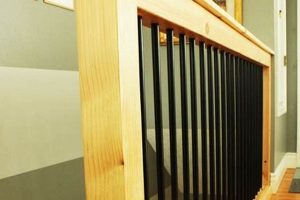A ductless system for cooling and heating spaces involves installing the components of a split-system air conditioner without professional assistance. This typically entails mounting an outdoor compressor/condenser unit and one or more indoor evaporator units, connecting them with refrigerant lines and electrical wiring, and then charging the system. The undertaking is attractive to those seeking to avoid professional installation costs.
The allure of such projects stems from potential cost savings and the satisfaction of completing home improvement independently. Historically, HVAC system installations were exclusively the domain of licensed professionals. However, the emergence of pre-charged linesets and simplified installation kits has made the prospect of self-installation more feasible for homeowners with sufficient technical aptitude. The benefits, when executed correctly, include efficient zone-based temperature control and reduced energy consumption.
The following sections will address the essential aspects of undertaking this type of project, including necessary tools and safety precautions, installation steps, potential challenges and troubleshooting tips, as well as legal and warranty considerations.
DIY Mini Split AC Installation Tips
Successful self-installation of a ductless mini-split system requires meticulous planning and execution. The following tips are designed to enhance the likelihood of a problem-free installation and optimal system performance.
Tip 1: Thoroughly Review Local Building Codes: Prior to commencing any work, confirm that local regulations permit this type of self-installation. Some jurisdictions may require permits or inspections, even for systems utilizing pre-charged linesets. Failure to comply can result in fines or mandatory professional remediation.
Tip 2: Invest in Quality Tools: While installation kits may include basic tools, consider acquiring a torque wrench, vacuum pump, manifold gauge set, and refrigerant leak detector. Using professional-grade tools ensures accurate connections, proper vacuuming of the refrigerant lines, and leak-free operation.
Tip 3: Properly Size the System: Undersized or oversized systems operate inefficiently and may not effectively cool or heat the designated space. Conduct a heat load calculation or consult with an HVAC professional to determine the appropriate BTU rating for the intended area. Factors such as insulation levels, window sizes, and sun exposure should be considered.
Tip 4: Vacuum the Refrigerant Lines Thoroughly: Evacuating the refrigerant lines is crucial to remove moisture and non-condensable gases. Use a vacuum pump to pull a deep vacuum (typically below 500 microns) and hold it for at least one hour. This ensures optimal refrigerant performance and prevents damage to the compressor.
Tip 5: Securely Mount the Outdoor Unit: The outdoor compressor/condenser unit should be mounted on a level, stable surface. Ensure adequate clearance around the unit for proper airflow and maintenance access. Consider using vibration isolation pads to minimize noise transmission.
Tip 6: Double-Check All Electrical Connections: Before energizing the system, meticulously inspect all electrical connections for tightness and proper polarity. Incorrect wiring can damage the system and pose a safety hazard. Turn off the breaker before performing any electrical work.
Tip 7: Preserve Documentation: Throughout the installation process, document each step with photos and detailed notes. This documentation can be invaluable for troubleshooting future issues or for warranty claims. Keep all receipts and manuals in a safe place.
Adhering to these guidelines can improve the outcome of a “do-it-yourself” project, leading to a reliable and efficient home climate control solution.
The final section will address potential warranty implications and the importance of professional consultation in certain situations.
1. Code Compliance
Adherence to local building codes and regulations is paramount when undertaking a “do-it-yourself” mini-split air conditioner installation. Failure to comply can result in fines, mandatory system modifications, or even legal action.
- Permitting Requirements
Many jurisdictions require permits for HVAC installations, regardless of whether the work is performed by a licensed professional or a homeowner. The permitting process ensures that the installation meets minimum safety and energy efficiency standards. Failure to obtain required permits can lead to fines and potential difficulty selling the property in the future. For example, a homeowner installing a system without a permit might be required to remove it entirely if discovered during a subsequent inspection.
- Electrical Codes
Electrical work associated with mini-split systems, including wiring and circuit breaker installation, must conform to local electrical codes. These codes specify wire gauges, grounding requirements, and overcurrent protection measures to prevent electrical fires and ensure safe operation. Improper electrical connections can create fire hazards and void warranties. A common violation is using undersized wiring, which can overheat and cause a fire.
- Refrigerant Handling Regulations
Regulations govern the handling of refrigerants to minimize environmental impact. These regulations may dictate the types of refrigerants permitted, the procedures for handling and disposal, and the certification required for individuals working with refrigerants. Venting refrigerant into the atmosphere is illegal and environmentally damaging. DIY installers should use pre-charged linesets to avoid handling refrigerant directly.
- Structural Requirements
The mounting of both the indoor and outdoor units must meet structural requirements to ensure stability and prevent damage. Outdoor units, in particular, require secure mounting on a level surface, often a concrete pad or wall-mounted bracket, capable of supporting the unit’s weight and withstanding wind loads. Indoor units must be securely attached to walls to prevent them from falling. A poorly mounted outdoor unit could topple over in high winds, causing damage to the unit and surrounding property.
These facets of code compliance directly impact the feasibility and legality of a “do-it-yourself” mini-split AC project. Understanding and adhering to these regulations is essential for ensuring a safe, efficient, and legally compliant installation. Ignoring them introduces significant risk and potential expense.
2. Tool Investment
The successful implementation of a “do-it-yourself” mini-split AC installation hinges significantly on the investment in appropriate tools. Insufficient or inadequate tools not only complicate the installation process but also
increase the risk of errors that can compromise system performance and longevity. The cause-and-effect relationship is direct: high-quality tools facilitate precise connections, accurate measurements, and safe handling of components, leading to a properly functioning system. Conversely, relying on substandard tools can result in leaks, electrical shorts, or structural instability.
As a critical component of “do-it-yourself” installation, selecting the correct tools is paramount. A torque wrench, for example, ensures that refrigerant line connections are tightened to the manufacturer’s specifications, preventing leaks that can reduce cooling efficiency and release harmful refrigerants. A vacuum pump is essential for removing moisture and non-condensable gases from the refrigerant lines, a process vital for maintaining optimal system performance. A manifold gauge set provides accurate pressure readings, enabling installers to monitor system performance and diagnose potential issues. A refrigerant leak detector is indispensable for identifying leaks, preventing refrigerant loss and environmental damage.
In summary, adequate tool investment is not merely a matter of convenience; it is a prerequisite for a successful and reliable “do-it-yourself” mini-split AC installation. While the initial cost of acquiring high-quality tools may seem substantial, it is significantly less than the cost of rectifying errors caused by using inadequate tools or the expense of hiring a professional to correct a botched installation. Furthermore, proper tool selection enhances safety and minimizes the risk of personal injury or property damage.
3. Correct Sizing
The accurate determination of a mini-split AC system’s capacity is a critical prerequisite for effective and efficient climate control. In the context of a “diy mini split ac” project, proper sizing directly impacts system performance, energy consumption, and the overall return on investment. An undersized system will struggle to maintain the desired temperature during peak load conditions, resulting in discomfort and prolonged operation at maximum capacity. This sustained strain can shorten the lifespan of the components and increase energy bills. Conversely, an oversized system may cycle on and off frequently, leading to temperature fluctuations, inefficient dehumidification, and premature wear. The practical consequence is a less comfortable environment and higher operating costs than necessary.
The heat load calculation is the cornerstone of correct sizing. This process involves assessing factors such as the area’s square footage, insulation levels, window types and sizes, orientation relative to the sun, occupancy levels, and heat-generating appliances. Manual heat load calculations are possible, but readily available software tools and online calculators can streamline the process and improve accuracy. For example, a room with large, unshaded windows facing south will require a higher BTU rating than a similar room with well-insulated walls and smaller, shaded windows. Overlooking these variables can lead to significant errors in system selection. Consulting with an HVAC professional to validate heat load calculations is advisable, particularly for complex projects or when energy efficiency is a primary concern.
In conclusion, accurate sizing is not merely a technical detail but a fundamental aspect of a successful “diy mini split ac” installation. It requires careful consideration of the specific space, a thorough heat load calculation, and potentially, professional consultation. The ramifications of incorrect sizing extend beyond immediate comfort issues to encompass long-term energy costs, equipment lifespan, and overall system effectiveness. Prioritizing this step is essential for maximizing the benefits of a self-installed mini-split system.
4. Vacuum Integrity
Vacuum integrity is a crucial factor affecting the performance and longevity of any split-system air conditioning unit, including those installed via “diy mini split ac” methods. The removal of non-condensable gases and moisture from the refrigerant lines is essential for efficient operation and system durability.
- Moisture Removal
Moisture within a refrigerant system can lead to the formation of acids and sludge, which can corrode internal components, restrict refrigerant flow, and ultimately cause compressor failure. Effective evacuation using a vacuum pump lowers the boiling point of water, allowing it to vaporize and be removed from the system. For example, even a small amount of moisture can significantly reduce the system’s cooling capacity and efficiency, leading to increased energy consumption and potential breakdowns.
- Non-Condensable Gas Elimination
Non-condensable gases, such as air, nitrogen, and oxygen, can increase the system’s operating pressure, reduce cooling capacity, and cause the compressor to work harder. These gases do not condense at the same temperature as the refrigerant, leading to inefficient heat transfer. Proper evacuation removes these gases, ensuring that the system operates at its designed pressure and efficiency levels. Failure to remove these gases can result in higher energy bills and premature component failure.
- Achieving Deep Vacuum
Achieving a deep vacuum, typically below 500 microns, is necessary for effective moisture and non-condensable gas removal. This requires a high-quality vacuum pump and accurate measurement tools, such as a micron gauge. Simply relying on a vacuum pump alone is insufficient; the vacuum level must be monitored and maintained for a sufficient period to ensure complete evacuation. For instance, a DIY installer may use a less powerful vacuum pump, resulting in an incomplete evacuation and subsequent performance issues.
- Leak Prevention
Maintaining vacuum integrity after evacuation is critical. Leaks in refrigerant lines or connections can allow air and moisture to re-enter the system, negating the benefits of the evacuation process. Proper torqueing of connections and the use of leak detection methods are essential for preventing leaks. A leak, even a small one, can gradually degrade the system’s performance and eventually lead to a complete refrigerant loss, requiring costly repairs. Therefore, thorough leak testing after evacuation is an indispensable step.
The outlined facets of vacuum integrity are foundational for ensuring the optimal functioning of systems established through “diy mini split ac” installations. A thorough comprehension and meticulous application of proper evacuation techniques serve as essential components for achieving efficient and durable climate control outcomes.
5. Secure Mounting
Secure mounting of both the indoor and outdoor units is a non-negotiable requirement for any “diy mini split ac” installation. Improperly secured components not only pose immediate safety hazards but also contribute to premature system failure and decreased efficiency. Adequate mounting ensures stable operation and prolongs the lifespan of the equipment.
- Structural Integrity
The mounting surface must possess sufficient load-bearing capacity to support the weight of the
unit, accounting for operational vibrations and potential environmental loads such as wind or snow. Failing to ensure adequate structural support can result in the unit detaching, causing property damage, personal injury, or system malfunction. For example, an outdoor condenser unit affixed to a deteriorated wooden deck is at risk of collapsing, particularly under the weight of accumulated snow. - Vibration Isolation
Mini-split systems generate vibrations during operation, particularly within the outdoor compressor unit. Direct mounting to a building structure can transmit these vibrations, resulting in noise pollution and potential structural damage over time. Vibration isolation pads or mounts mitigate these effects by dampening vibrations and reducing noise transmission. Ignoring vibration isolation measures can lead to complaints from neighbors and accelerated wear on the mounting hardware.
- Environmental Protection
Proper mounting elevates the units above ground level, protecting them from moisture, debris, and potential flooding. Ground-level installations are susceptible to corrosion, insect infestation, and damage from lawn maintenance equipment. Elevated mounting improves airflow around the units, contributing to efficient heat exchange and preventing overheating. For example, an outdoor unit placed directly on the ground is more likely to become clogged with leaves and debris, hindering its performance.
- Accessibility for Maintenance
Strategic mounting locations provide adequate clearance around the units for routine maintenance and repairs. Restricted access can complicate servicing, increasing the time and cost required for maintenance. Accessible mounting allows technicians to easily inspect, clean, and repair components without dismantling surrounding structures. A common oversight is mounting the outdoor unit too close to a wall, restricting access to service panels and refrigerant connections.
The various elements of secure mounting, when collectively implemented, directly contribute to the safety, efficiency, and longevity of a “diy mini split ac” system. Neglecting these aspects introduces preventable risks and diminishes the potential benefits of self-installation.
Frequently Asked Questions
This section addresses common inquiries regarding the feasibility, requirements, and potential challenges associated with self-installing ductless mini-split air conditioning systems.
Question 1: Is self-installation of a mini-split AC system legal?
Legality varies by jurisdiction. Many localities require permits for HVAC installations, regardless of whether the work is performed by a licensed professional or a homeowner. Confirm local building codes and regulations prior to commencing any work. Failure to comply can result in fines or mandatory system modifications.
Question 2: What are the primary safety concerns associated with DIY mini-split AC installation?
Electrical hazards, refrigerant handling risks, and the potential for structural instability constitute the primary safety concerns. Incorrect wiring can lead to electrical shock or fire. Improper refrigerant handling can result in environmental damage and health risks. Insufficient structural support can cause the units to detach, resulting in property damage or personal injury. Adherence to safety guidelines and proper tool usage is paramount.
Question 3: Can self-installation void the manufacturer’s warranty?
Yes, self-installation frequently voids the manufacturer’s warranty. Many manufacturers require professional installation by a licensed HVAC technician to validate the warranty. Review the warranty terms and conditions carefully before proceeding with self-installation. Consider the potential cost of future repairs in the absence of warranty coverage.
Question 4: What specific tools are required for DIY mini-split AC installation beyond those included in standard kits?
While installation kits may include basic tools, several specialized tools enhance the likelihood of a successful installation. These include a torque wrench for precise tightening of refrigerant line connections, a vacuum pump for effective evacuation of refrigerant lines, a manifold gauge set for monitoring system pressures, and a refrigerant leak detector for identifying potential leaks. Investing in these tools is advisable for optimal results.
Question 5: How critical is the heat load calculation for DIY mini-split AC installation?
The heat load calculation is crucial for determining the appropriate BTU rating of the system. An undersized system will struggle to maintain the desired temperature, while an oversized system may cycle on and off frequently, leading to temperature fluctuations and inefficient dehumidification. Conduct a thorough heat load calculation or consult with an HVAC professional to ensure proper sizing.
Question 6: What are the most common mistakes made during DIY mini-split AC installation?
Common mistakes include neglecting local building codes, failing to properly vacuum the refrigerant lines, using incorrect electrical wiring, improperly securing the units, and neglecting to perform a thorough leak test. These errors can lead to reduced system performance, increased energy consumption, and potential component failure. Meticulous attention to detail and adherence to installation guidelines are essential for avoiding these mistakes.
Proper planning and execution are critical to mitigating the risks associated with this type of project.
The subsequent section provides a comparative analysis of professional versus DIY mini-split AC installation.
Conclusion
The preceding analysis demonstrates that “diy mini split ac” installations present a complex undertaking with potential benefits and inherent risks. Thorough adherence to safety protocols, meticulous planning, and a comprehensive understanding of HVAC principles are essential for a successful outcome. Code compliance and proper tool utilization represent critical components of the process.
Prospective installers should carefully weigh the potential cost savings against the technical challenges and warranty implications. Prudent evaluation of skills, adherence to regulations, and meticulous execution determine the ultimate success of the project. The decision to pursue “diy mini split ac” requires careful consideration, as long-term system performance and personal safety are paramount.







